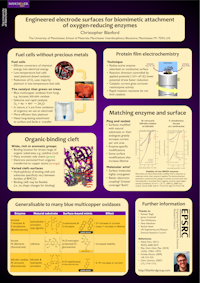Research Summary
Group Research
Oriented enzyme attachment
 |
| Biomimetic attachment of multicopper oxidases (1.7 MB download) |
Creating an enzyme-modified electrode capable of bioelectrocatalysis is relatively straightforward through surface adsorption from a pure enzyme solution. We’re working to elevate this methodology through rational surface modifications and modifications to the protein structure that can exploit the “lock-and-key” specificity between enzyme and its substrates.
On two-dimensional surfaces, our principal approach to characterise the interaction between an electrode surface and the proteins on it is the quartz crystal microbalance coupled to electrochemical measurement equipment. These techniques are complemented by infrared and visible spectroscopy and X-ray crystallography.
Structured electrodes for enzymatic biofuel cells
Our group is also investigating scale-up of electrode current density. Here the research acquires additional dimensions of complexity, particularly with respect to electrode creation and product analysis. Porous materials have a remarkable capacity for adsorption, hence the widespread use of activated carbons as “sponges” for odours, solvents and biomolecules. Again, simple adsorption of protein to create an enzyme-modified cathode is straightforward, but to ensure long-term stability and to make efficient use of these biological catalysts, the electrode materials must have fast diffusion paths for reactants and products, and low-resistance connections throughout the framework. We use nitrogen porosimetry and other adsorption and intrusion techniques to investigate the framework materials, and alternating current/Fourier-transform electrochemical techniques to analyse the redox response of embedded redox-active species. Beyond the materials selection and engineering aspects of mass and electron transport in bicontinuous porous networks, we are investigating how proteins behave when entrapped in dimensionally restricted and confined environments very different from their natural ones.
Currently, carbon and gold are the main surfaces we use, but we are expanding into conductive and redox-active metal oxide films and other engineered coating materials.
Modelling enzyme voltammetry
We complement our protein film electrochemistry with computational modelling of the electrocatalytic response of fully competent enzyme. The O2-reduction kinetics of multicopper oxidases varies significantly between members of this class of enzymes. We use these models to quantify these differences, then connect our measurements to structural differences.
Collaborators
Prof. Fraser A. Armstrong, FRS
Inorganic Chemistry Laboratory, University of Oxford
Prof. Sabine L. Flitsch
School of Chemistry, University of Manchester
Prof. Elspeth Garman
Laboratory of Molecular Biophysics, University of Oxford
Prof. Sarah J. Gurr
Department of Plant Sciences, University of Oxford
Dr Sarah J. Haigh
School of Materials, University of Manchester
Dr Nina Hakulinen
Department of Chemistry, University of Joensuu, Finland
Dr Rob Jacobs
Chemistry Research Laboratory, University of Oxford
Dr Enrique Rudiño Piñera
Instituto de Biotecnología, Universidad Nacional Autónoma de México
Dr Andrew Watt
Department of Materials, University of Oxford
Dr Luet-Lok Wong
Inorganic Chemistry Laboratory, University of Oxford
MetGen Oy
Turku, Finland